Abstract
Accurate assessment of aboveground biomass (AGB) is crucial for understanding carbon budgets, climate change impacts, and evaluating forest responses to environmental shifts. In this study, AGB was estimated in Sikkim State of India by leveraging the capabilities of machine learning (ML) and integrating multi-sensor satellite data. Specifically, the random forest (RF) and categorical boosting algorithm (CatBoost) models were utilised. Field estimated AGB ranges from 1.99 to 530.02 Mg/ha with an average of 252.58 Mg/ha, utilised for model prediction and validation. The RF model slightly outperformed the CatBoost model, with a coefficient of determination (R2) of 0.71 and root mean square error (RMSE) of 72.98 Mg/ha, compared to the CatBoost model’s R2 of 0.67 and RMSE of 80.69 Mg/ha, The former showed a greater capacity to combat overfitting. Synthetic aperture radar variables have emerged as significant predictors because of their contribution to the structural properties of plants. This study acknowledges the limitations and challenges due to data availability, especially for ground truth measurements, which pose constraints on the accuracy and representativeness of AGB estimates. Uncertainties associated with AGB estimation, such as variations in vegetation structure and species composition, also affected model performance. Despite these limitations, this study emphasises the significance of multi-sensor data integration and ML models in AGB estimation and highlights their potential applications in forest management and climate change mitigation efforts in the Himalayan mountainous region.







Similar content being viewed by others
References
Avitabile, V., Herold, M., Heuvelink, G. B. M., Lewis, S. L., Phillips, O. L., Asner, G. P., et al. (2016). An integrated pan-tropical biomass map using multiple reference datasets. Global Change Biology, 22(4), 1406–1420. https://doi.org/10.1111/gcb.13139
Baccini, A., Walker, W., Carvalho, L., Farina, M., & Houghton, R. A. (2019). Tropical forests are a net carbon source based on aboveground measurements of gain and loss. Science, 363(6423), 230–234. https://doi.org/10.1126/science.aat1205
Behera, M. D., Tripathi, P., Mishra, B., Kumar, S., Chitale, V. S., & Behera, S. K. (2016). Above-ground biomass and carbon estimates of Shorea robusta and Tectona grandis forests using QuadPOL ALOS PALSAR data. Advances in Space Research, 57(2), 552–561. https://doi.org/10.1016/j.asr.2015.11.010
Belgiu, M., & Drăgu, L. (2016). Random forest in remote sensing: A review of applications and future directions. ISPRS Journal of Photogrammetry and Remote Sensing, 114, 24–31. https://doi.org/10.1016/j.isprsjprs.2016.01.011
Breiman, L. (2001). Random Forests. Machine Learning, 45(1), 5–32. https://doi.org/10.1023/A:1010933404324
Dang, A. T. N., Nandy, S., Srinet, R., Luong, N. V., Ghosh, S., & Senthil Kumar, A. (2019). Forest aboveground biomass estimation using machine learning regression algorithm in Yok Don National Park. Vietnam. Ecological Informatics, 50, 24–32. https://doi.org/10.1016/j.ecoinf.2018.12.010
David, R. M., Rosser, N. J., & Donoghue, D. N. M. (2022). Improving above ground biomass estimates of Southern Africa dryland forests by combining Sentinel-1 SAR and Sentinel-2 multispectral imagery. Remote Sensing of Environment, 282, 113232. https://doi.org/10.1016/j.rse.2022.113232
Dorogush, A. V., Ershov, V., & Gulin, A. (2018). CatBoost: gradient boosting with categorical features support. arXiv preprint arXiv:1810.11363
Fassnacht, F. E., Latifi, H., Stereńczak, K., Modzelewska, A., Lefsky, M., Waser, L. T., et al. (2016). Review of studies on tree species classification from remotely sensed data. Remote Sensing of Environment, 186, 64–87. https://doi.org/10.1016/j.rse.2016.08.013
Forkuor, G., Benewinde Zoungrana, J.-B., Dimobe, K., Ouattara, B., Vadrevu, K. P., & Tondoh, J. E. (2020). Above-ground biomass mapping in West African dryland forest using Sentinel-1 and 2 datasets - A case study. Remote Sensing of Environment, 236, 111496. https://doi.org/10.1016/j.rse.2019.111496
FSI.(1996). Volume equations for forests of India, Nepal and Bhutan. Forest Survey of India, Ministry of Environment and Forests, Govt. of India, Dehradun
FSI. (2019). India state of forest report. Forest Survey of India
FSI. (2021). India State of Forest Report. Dehradun: Forest Survey of India, Ministry of Environment Forest and Climate Change
Ghosh, S. M., & Behera, M. D. (2018). Aboveground biomass estimation using multi-sensor data synergy and machine learning algorithms in a dense tropical forest. Applied Geography, 96, 29–40. https://doi.org/10.1016/j.apgeog.2018.05.011
Ghosh, S. M., Behera, M. D., Jagadish, B., Das, A. K., & Mishra, D. R. (2021). A novel approach for estimation of aboveground biomass of a carbon-rich mangrove site in India. Journal of Environmental Management, 292, 112816. https://doi.org/10.1016/j.jenvman.2021.112816
Ghosh, S. M., Behera, M. D., Kumar, S., Das, P., Prakash, A. J., Bhaskaran, P. K., et al. (2022a). Predicting the forest canopy height from lidar and multi-sensor data using machine learning over India. Remote Sensing. https://doi.org/10.3390/rs14235968
Ghosh, S. M., Behera, M. D., Kumar, S., Das, P., Prakash, A. J., Bhaskaran, P. K., & Behera, S. K. (2022b). Predicting the forest canopy height from LiDAR and multi-sensor data using machine learning over India. Remote Sensing, 14(23), 5968.
Guerra-Hernández, J., Narine, L. L., Pascual, A., Gonzalez-Ferreiro, E., Botequim, B., Malambo, L., et al. (2022). Aboveground biomass mapping by integrating ICESat-2, SENTINEL-1, SENTINEL-2, ALOS2/PALSAR2, and topographic information in Mediterranean forests. Giscience & Remote Sensing, 59(1), 1509–1533. https://doi.org/10.1080/15481603.2022.2115599
Hancock, J. T., & Khoshgoftaar, T. M. (2020). CatBoost for big data: An interdisciplinary review. Journal of Big Data, 7(1), 94. https://doi.org/10.1186/s40537-020-00369-8
Jha, N., Tripathi, N. K., Barbier, N., Virdis, S. G. P., Chanthorn, W., Viennois, G., et al. (2021). The real potential of current passive satellite data to map aboveground biomass in tropical forests. Remote Sensing in Ecology and Conservation, 7(3), 504–520. https://doi.org/10.1002/rse2.203
Kuhn, M. (2008). Building Predictive Models in R Using the caret Package. Journal of Statistical Software, 28(5), 1–26. https://doi.org/10.18637/jss.v028.i05
Li, Y., Li, M., Li, C., & Liu, Z. (2020). Forest aboveground biomass estimation using Landsat 8 and Sentinel-1A data with machine learning algorithms. Scientific Reports, 10(1), 9952. https://doi.org/10.1038/s41598-020-67024-3
Lu, D., Chen, Q., Wang, G., Liu, L., Li, G., & Moran, E. (2016). A survey of remote sensing-based aboveground biomass estimation methods in forest ecosystems. International Journal of Digital Earth, 9(1), 63–105. https://doi.org/10.1080/17538947.2014.990526
Luo, M., Wang, Y., Xie, Y., Zhou, L., Qiao, J., Qiu, S., & Sun, Y. (2021). Combination of feature selection and catboost for prediction: The first application to the estimation of aboveground biomass. Forests. https://doi.org/10.3390/f12020216
Malhi, R. K. M., Anand, A., Srivastava, P. K., Chaudhary, S. K., Pandey, M. K., Behera, M. D., et al. (2021). Synergistic evaluation of Sentinel 1 and 2 for biomass estimation in a tropical forest of India. Advances in Space Research. https://doi.org/10.1016/j.asr.2021.03.035
Mutanga, O., Masenyama, A., & Sibanda, M. (2023). Spectral saturation in the remote sensing of high-density vegetation traits: A systematic review of progress, challenges, and prospects. ISPRS Journal of Photogrammetry and Remote Sensing, 198, 297–309. https://doi.org/10.1016/j.isprsjprs.2023.03.010
Nandy, S., Srinet, R., & Padalia, H. (2021). Mapping forest height and aboveground biomass by integrating ICESat-2, sentinel-1 and sentinel-2 data using random forest algorithm in northwest himalayan foothills of India. Geophysical Research Letters. https://doi.org/10.1029/2021GL093799
Prakash, A. J., Behera, M. D., Ghosh, S. M., Das, A., & Mishra, D. R. (2022). A new synergistic approach for Sentinel-1 and PALSAR-2 in a machine learning framework to predict aboveground biomass of a dense mangrove forest. Ecological Informatics. https://doi.org/10.1016/j.ecoinf.2022.101900
Rosenqvist, A., Shimada, M., Suzuki, S., Ohgushi, F., Tadono, T., Watanabe, M., et al. (2014). Operational performance of the ALOS global systematic acquisition strategy and observation plans for ALOS-2 PALSAR-2. Remote Sensing of Environment, 155, 3–12.
Sharma, N., Behera, M. D., Das, A. P., & Panda, R. M. (2019). Plant richness pattern in an elevation gradient in the Eastern Himalaya. Biodiversity and Conservation, 28(8), 2085–2104. https://doi.org/10.1007/s10531-019-01699-7
Shimada, M., Itoh, T., Motooka, T., Watanabe, M., Shiraishi, T., Thapa, R., & Lucas, R. (2014). New global forest/non-forest maps from ALOS PALSAR data (2007–2010). Remote Sensing of Environment, 155, 13–31.
Singh, C., Karan, S. K., Sardar, P., & Samadder, S. R. (2022). Remote sensing-based biomass estimation of dry deciduous tropical forest using machine learning and ensemble analysis. Journal of Environmental Management, 308, 114639. https://doi.org/10.1016/j.jenvman.2022.114639
Singh, R. K., Biradar, C. M., Behera, M. D., Prakash, A. J., Das, P., Mohanta, M. R., & Rizvi, J. (2023). Optimising carbon fixation through agroforestry: Estimation of aboveground biomass using multi-sensor data synergy and machine learning. Ecological Informatics, 79, 102408.
Nations, U. (2016). The Sustainable Development Goals 2016. eSocialSciences
Vaglio Laurin, G., Chen, Q., Lindsell, J. A., Coomes, D. A., Frate, F. D., Guerriero, L., et al. (2014a). Above ground biomass estimation in an African tropical forest with lidar and hyperspectral data. ISPRS Journal of Photogrammetry and Remote Sensing, 89, 49–58. https://doi.org/10.1016/j.isprsjprs.2014.01.001
Vaglio Laurin, G., Chen, Q., Lindsell, J. A., Coomes, D. A., Frate, F. D., Guerriero, L., et al. (2014b). Above ground biomass estimation in an African tropical forest with lidar and hyperspectral data. ISPRS Journal of Photogrammetry and Remote Sensing, 89, 49–58. https://doi.org/10.1016/j.isprsjprs.2014.01.001
Wang, J., Xiao, X., Bajgain, R., Starks, P., Steiner, J., Doughty, R. B., & Chang, Q. (2019). Estimating leaf area index and aboveground biomass of grazing pastures using Sentinel-1, Sentinel-2 and Landsat images. ISPRS Journal of Photogrammetry and Remote Sensing, 154, 189–201. https://doi.org/10.1016/j.isprsjprs.2019.06.007
Xiao, J., Chevallier, F., Gomez, C., Guanter, L., Hicke, J. A., Huete, A. R., et al. (2019). Remote sensing of the terrestrial carbon cycle: A review of advances over 50 years. Remote Sensing of Environment, 233, 111383. https://doi.org/10.1016/j.rse.2019.111383
Yu, Y., & Saatchi, S. (2016). Sensitivity of L-band SAR backscatter to aboveground biomass of global forests. Remote Sensing. https://doi.org/10.3390/rs8060522
Zhang, Y., Liang, S., & Sun, G. (2014). Forest biomass mapping of northeastern china using GLAS and MODIS data. IEEE Journal of Selected Topics in Applied Earth Observations and Remote Sensing, 7(1), 140–152. https://doi.org/10.1109/JSTARS.2013.2256883
Acknowledgements
AJP and SP thank the Ministry of Education, Government of India, for the grant of PhD Research Fellowships. SS thanks Ministry of Education, Government of India, New Delhi, for providing fellowship for M.Tech study. All Authors acknowledge the authorities of IIT Kharagpur for instrumental support and facilities provided; the Sikkim state forest and wildlife department is thanked for support in conducting fieldwork.
Funding
No external funding was received for this research.
Author information
Authors and Affiliations
Contributions
AJP and MDB contributed to the conceptualization, data curation, formal analysis, methodology, supervision, and writing—original draft. SP and SM were involved in the investigation, methodology, resources, supervision, and writing—review and editing. BRP and SS assisted in the visualization and writing—review and editing. NS contributed to writing—review and editing.
Corresponding author
Ethics declarations
Conflict of interest
Authors declare that there is no potential conflict of interest.
Additional information
Publisher's Note
Springer Nature remains neutral with regard to jurisdictional claims in published maps and institutional affiliations.
About this article
Cite this article
Prakash, A.J., Mudi, S., Paramanik, S. et al. Dominant Expression of SAR Backscatter in Predicting Aboveground Biomass: Integrating Multi-Sensor Data and Machine Learning in Sikkim Himalaya. J Indian Soc Remote Sens 52, 871–883 (2024). https://doi.org/10.1007/s12524-024-01812-6
Received:
Accepted:
Published:
Issue Date:
DOI: https://doi.org/10.1007/s12524-024-01812-6




